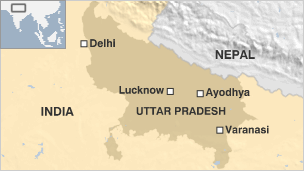It’s the most populous state in the world’s largest democracy.![]()
It’s the great heartland of Hindustan along India’s north-central border, home to the Taj Mahal, home to seven of India’s 13 prime ministers, and the traditional base of the Nehru-Gandhi family, which has given India three prime ministers, and hopes to give India its next prime minister in Rahul Gandhi.
It’s Uttar Pradesh (which translates to ‘northern province’), and Narendra Modi’s path to becoming India’s next prime minister runs right through it.
A sketch of India’s most populous state
With 199.6 million residents, it’s nearly as populous as Brazil — and with 80 seats up for grabs in the 545-member Lok Sabha (लोक सभा), the state is by far the largest prize in India’s parliamentary elections, which kick off April 7 and will be conducted in nine phases that conclude on May 12. Given the sheer size of the state, voters in Uttar Pradesh will go to the polls in six of the nine phases,** spanning virtually the entire voting season.
That means that Uttar Pradesh holds about one-third of the seats any party would need to win a majority in the Lok Sabha, the lower (and more consequential) house of the Indian parliament.
Though it lies in the heart of the ‘Hindi belt,’ which might otherwise make it fertile territory for Modi’s conservative, Hindu nationalist Bharatiya Janata Party (the BJP, भारतीय जनता पार्टी), it won’t necessarily be the easiest sell for Modi, the chief minister of Gujarat since 2001.
In contrast to Gujarat, which is one of the wealthiest states of India, Uttar Pradesh is one of the poorest — it had a state GDP per capita of around $1,586 (as of 2009), less than 50% of Gujarat’s equivalent. Continue reading The path to India’s next government runs through Uttar Pradesh

